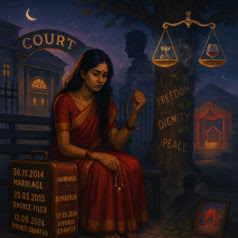Case Overview
In a landmark judgment delivered on September 12, 2024, the
Patna High Court granted divorce to Shweta Singh, overturning a family court’s
earlier rejection. This case (Miscellaneous Appeal No. 461 of 2023) stands as a
powerful testament to how judicial silence and abandonment can constitute
cruelty in matrimonial relationships.
The Story Behind the Legal Battle
Shweta Singh’s journey began with what should have been a
joyful union. Married to Pranav Kumar Singh on November 30, 2014, according to
Hindu rites in Patna, she brought substantial gifts to the marriage – ten lakh
rupees in cash, 12 grams of gold, 500 grams of silver, and various household
items including television, refrigerator, and washing machine.
However, the fairy tale quickly turned into a nightmare.
Within days of joining her matrimonial home on December 1, 2014, Shweta faced
demands for additional dowry. When her family couldn’t meet these demands, she
was subjected to harassment and physical assault by her husband and in-laws.
The situation became so unbearable that she was forced to leave the matrimonial
home on December 5, 2014 – merely four days after arriving.
A temporary reconciliation occurred on January 17, 2015,
when Shweta returned following negotiations by her parents. However, the
respite was short-lived. The torture and dowry demands resumed, forcing her to
permanently leave on March 20, 2015. What makes this case particularly poignant
is the allegation that the marriage was never consummated, and despite repeated
attempts by her family to reconcile, the husband categorically refused to take
her back.
The Legal Journey
After exhausting all possible avenues for reconciliation,
Shweta filed for divorce on January 3, 2018, under Section 13(A) of the Hindu
Marriage Act, citing cruelty as grounds. The family court initially rejected
her petition in May 2023, leading to this appeal before the Patna High Court.
The respondent’s behavior throughout the legal proceedings
was telling – he never appeared before either the trial court or the High
Court, despite proper service of notices. This absence became a crucial factor
in the High Court’s decision.
Key Legal Arguments and Evidence
Shweta’s case rested on several pillars:
- Pattern
of Harassment: Systematic torture and dowry demands from the husband
and his family - Physical
Separation: Continuous separation since March 20, 2015 – over eight
years by the time of the High Court judgment - Husband’s
Indifference: Complete lack of response to legal proceedings and no
attempt to restore conjugal life - Non-consummation:
Allegation that the marriage was never physically consummated
The evidence included testimony from Shweta herself (AW-1)
and her father Vijay Kumar Singh (AW-2), along with marriage documentation.
Both witnesses corroborated the allegations of torture, dowry demands, and the
husband’s drinking habits that led to violent behavior.
The Family Court’s Reasoning (Overturned)
The family court had dismissed the petition on technical
grounds, arguing that:
- Shweta
failed to file complaints with appropriate authorities about the cruel
treatment - The
evidence didn’t specifically detail the nature of torture - During
testimony, she didn’t explicitly state the marriage wasn’t consummated - The
allegations amounted to “trivial matrimonial disputes” rather
than legal cruelty
The High Court’s Revolutionary Approach
Justice Alok Kumar Pandey, writing for the division bench,
took a fundamentally different approach, emphasizing several crucial
principles:
1. Social Justice Adjudication
The court recognized that family matters require a different
judicial approach than criminal cases. Rather than demanding proof “beyond
reasonable doubt,” family courts should apply the “preponderance of
probability” standard, being sensitive to the inherent power imbalances in
matrimonial disputes.
2. Redefining Cruelty
Drawing from Supreme Court precedents, particularly Roopa
Soni vs. Kamalnarayan Soni (2023) and Samar Ghosh vs. Jaya Ghosh
(2007), the court emphasized that cruelty has no fixed definition. It must be
understood contextually, considering the parties’ social background, economic
conditions, and cultural values.
The court noted that cruelty can be mental as well as
physical, and importantly, it can emerge from a pattern of conduct rather than
isolated incidents. The husband’s complete indifference and abandonment over
eight years constituted mental cruelty.
3. The Eloquence of Absence
Perhaps most significantly, the court treated the husband’s
consistent non-appearance as evidence itself. The judgment observed that a
person who cannot be bothered to defend his marriage in court cannot be
expected to show “scant regard for the feelings and emotions” of his
wife.
4. Time as a Factor
The court was deeply moved by the temporal aspect – Shweta
had lost nine precious years (from age 26 to 35) fighting for her freedom. The
judgment emphasized that “the span of life cannot be expanded,” and
forcing someone to remain in a dead marriage indefinitely amounts to cruelty.
Legal Precedents and Interpretation
The judgment extensively relied on Supreme Court precedents
to establish that:
- Dr.
N.G. Dastane vs. Mrs. S. Dastane (1975): Cruelty includes conduct
causing reasonable apprehension of harm - V.
Bhagat vs. D. Bhagat (1994): Mental cruelty requires examining the
impact on the affected spouse’s mind - Samar
Ghosh vs. Jaya Ghosh (2007): Courts must consider the entire
matrimonial relationship, not isolated incidents
Conclusion
The Patna High Court’s judgment in Shweta Singh vs.
Pranav Kumar Singh represents a paradigm shift in how Indian courts
approach matrimonial disputes. By recognizing that silence can be as cruel as
violence, and that abandonment can be as harmful as abuse, the court has taken
a progressive stance that prioritizes human dignity over legal technicalities.
The case sends a clear message: marriage is a partnership
requiring mutual respect, care, and presence. When one party completely
abandons their matrimonial obligations – not just physically but emotionally
and legally – it constitutes grounds for dissolution.
Read the full judgement Below;








